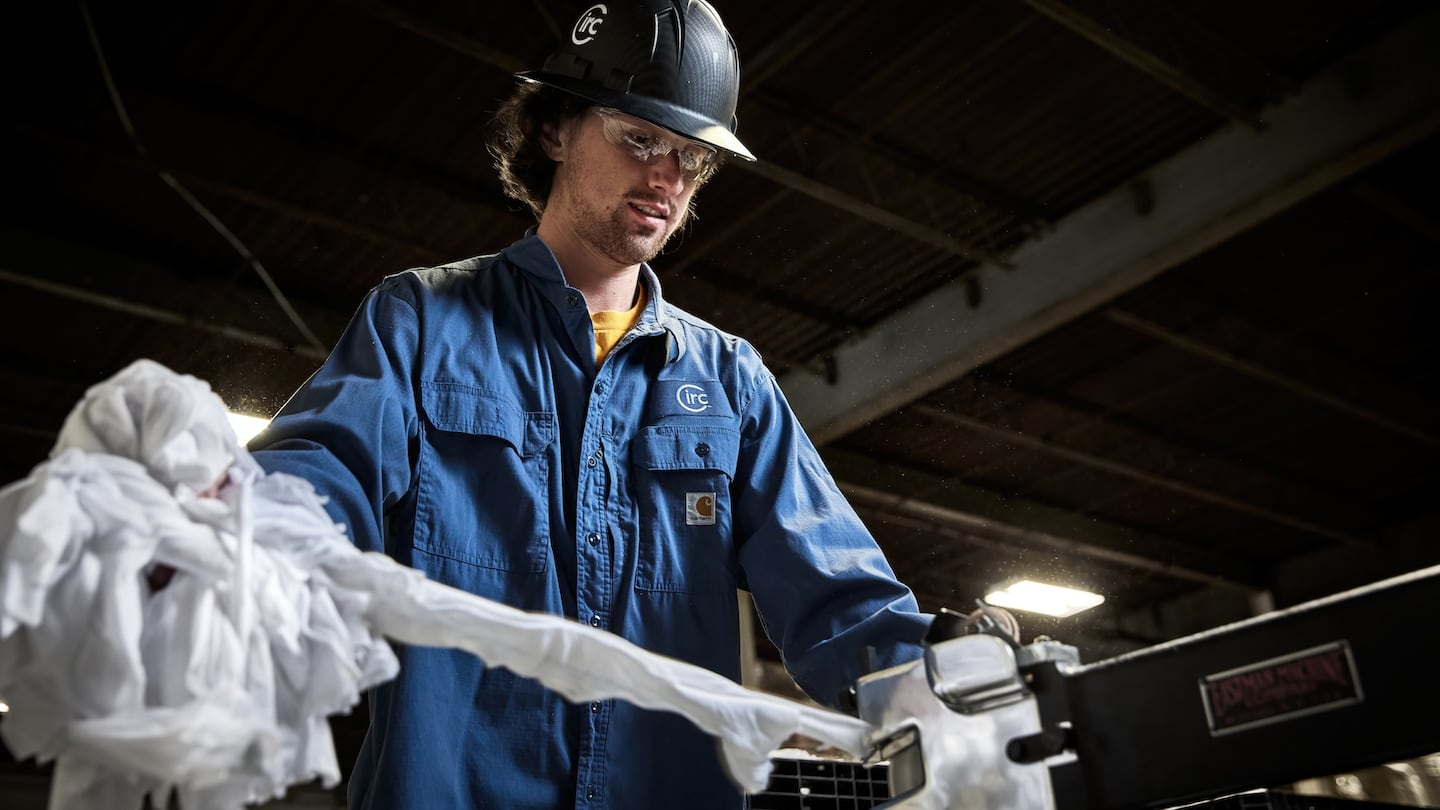Agenda-setting intelligence, analysis and advice for the global fashion community.
For years, the fashion industry has held up new textile recycling technologies as an almost holy-grail-like solution to many of the industry’s environmental ills. But proving out this theory by bringing promising innovations to commercial scale has proved long and fraught.
However, the last month has shown signs of fresh momentum, with a flurry of start-ups advancing plans to construct their first industrial-scale recycling facilities.
In April, H&M-backed Syre signalled its initial intention to build a gigascale plant capable of producing 100,000 to 250,000 metric tonnes of recycled polyester every year in Vietnam. This week, Circ, a US-based start-up whose backers include Zara-owner Inditex, and Reju, a textile recycling venture owned by French engineering company Technip Energies, announced plans to build their first industrial-scale plants in France and the Netherlands respectively.
“Our first full-scale facility will push circular fashion over the critical tipping point in the global economy, proving that the future of textiles can be decarbonised, closer to waste-free, and regenerative by design,” Circ president Peter Majeranowski said in a statement. “It’s not just a major milestone for Circ, but a breakthrough for the entire circular economy at a time when the planet urgently needs scalable climate solutions.”
ADVERTISEMENT
Circ and Reju are aiming to complete construction and start operations at their new plants by 2028, paving the way to make tens of thousands of tonnes of polyester and cellulose recycled from old textiles available to the market for the first time. Syre is hoping to kick off the build in Vietnam in 2027 with a view to initiate production by 2029.
Even so, the volumes in question remain a tiny fraction of the overall textile market and the companies still need to secure hundreds of millions of dollars in financing before breaking ground. To do so, they’ll need to show they have taken steps to avoid the pitfalls that led industry pioneer Renewcell to bankruptcy last year.
Lessons Learned
When Swedish recycler Renewcell started operations at its newly finished industrial plant in 2022, it was hailed as a momentous sign of progress in fashion’s ambitions to address the glut of garments created by an ever-growing industry. It took a mere five months for things to fall apart.
Demand for the company’s recycled raw material was weaker than expected, as it struggled to navigate the industry’s complex supply chains and compete on price. Renewcell relaunched as Circulose after private equity firm Altor bought the company’s remaining assets out of administration last June, but the supply chain hurdles and price-sensivity it initially faced are even more acute now.
The upcoming generation of textile recyclers say they have strategies in place to manage the challenges Renewcell faced. A critical one is securing purchasing commitments from large brands, without which it will be impossible to raise the debt companies need to help build their industrial plants. Syre’s venture has been underwritten by a $600 million offtake agreement from H&M and it is working to secure others. Circ and Reju say they are both in advanced talks with potential brand partners.
In an intensely competitive market, the start-ups are also looking for ways to keep a control on prices. Though raw materials only make up a tiny fraction of the overall cost of a garment, any premium over conventional prices can quickly compound as a product moves through the many stages of the supply chain leading to inflated fabric prices. To combat this, recyclers are seeking to build up trusted networks of suppliers that can provide more certainty and transparency around pricing. Purchasing commitments from brands help with this, too.
“The ideal option is to have full pull-through so the material doesn’t get stuck in the supply chain and it makes it much easier to line up the supply chain because we’re confident there’s a customer,” said Majeranowski. “There’s so much work we’ve been doing to coordinate all of this and put it together so that when we turn on the factory, it runs smoothly.”
But demand is just one half of the challenge. The recyclers also need to show they can get hold of thousands of tonnes of used textiles to feed their industrial-scale facilities, a tricky feat in a space where there is no shortage of waste but textile collecting and sorting infrastructure is still nascent.
ADVERTISEMENT
“It doesn’t matter how many offtake contracts you have. … Nobody will invest unless you can tell them how you can fulfil your feedstock pipeline in organised fashion,” said Reju CEO Patrik Frisk.
Reju, whose €300 million ($338 million) plant will have the capacity to produce 50,000 tonnes of recycled plastic, is engaging with over 100 sorters in Europe and North America to secure a reliable and traceable source of old clothes to feed its factory. Reju’s technology is able to process a wide mix of fabrics, giving it more flexibility over the type of feedstock it can take compared to other start-ups, many of which have strict specifications over the mix of fabric they can take.
“We can take a very big funnel; everything nobody else wants,” said Frisk. “I’ll take your worst stuff; the stuff you normally would pay to incinerate.”
Circ, which can also process blended fabrics, is taking a slightly different approach. The company is expecting to initially source most of the 70,000 tonnes of feedstock its French plant will be able to process from post-industrial waste imported from factories around Europe and in North Africa. It hopes to be able to switch later to meet its raw material needs with predominantly post-consumer waste as textile collections and sorting infrastructure in the region improves.
“It’s a bit of a chicken and egg,” said Majeranowski.
Syre only signed its agreement to explore construction in Vietnam on the basis that the company anticipates securing a license that will allow it to import textile waste from neighbouring countries to help supply the factory.
At a moment where support for climate-friendly projects is wavering and becoming more politically fraught, government backing for costly, complex engineering projects is critical. Both France and the Netherlands are pushing to gain an edge in what they hope will be a green industrial revolution. For instance, Circ is hoping to gain access to grants and guarantees provided by the French government to help support new industrial projects. The countries have also pioneered policies to encourage more circularity in the textile space, with France the first country in the world to introduce a fee system to make brands bear the cost of managing clothing waste.
“There’s a lot of noise right now on ESG,” said Frisk. “There are people out there and countries and regions that are absolutely serious about this thing.”





